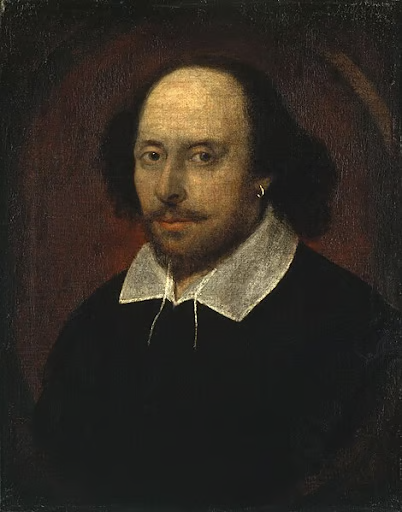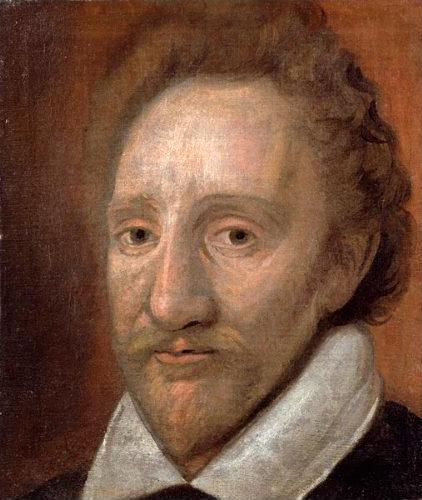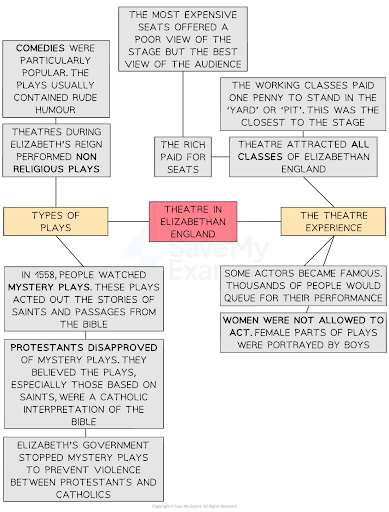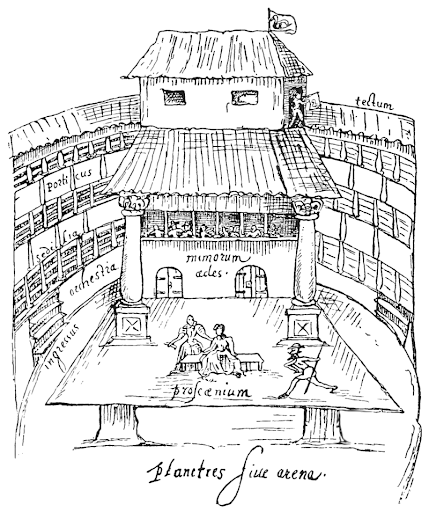Elizabethan Theatre (WJEC Eduqas GCSE History): Revision Note
Exam code: C100
What was the theatre like before the Elizabethan period? - Summary
Before the Elizabethan period, theatre in England was a basic and simple form of entertainment. Wandering bands of actors would travel and perform in local towns. Actors were often viewed with suspicion and considered lower-class and untrustworthy. Consequently, strolling players lacked the social respect and recognition they would later have.
Theatres before the Elizabethan period were typically held in makeshift venues such as inns, courtyards, open fields, or temporary stages. Permanent theatres did not exist before the Elizabethan period. Strolling players moved from town to town, performing wherever they could attract an audience. However, wealthier Tudors would sometimes have private showings of plays in their homes.
Pre-Elizabethan plays were mainly religious tales or simple farces. A popular play was Robin Hood; however, due to the key theme of this play, authorities soon called for it to be banned. It was not until the Elizabethan era, with the creation of permanent theatres like The Globe and the rise of influential playwrights like William Shakespeare, that theatre began to gain prominence and respectability in English society.
Elizabethan Theatre
Theatre became increasingly popular during Elizabeth's reign
England had no theatres in 1555
Many local authorities blocked the building of theatres because travelling actors impacted law and order, and a fear of spreading disease
In 1572, a law was passed banning strolling players from touring unless they had a licence
Licences were given to strolling players by the Lord Chamberlain
As a result, wealthier Elizabethans, known as patrons, decided to support actors
They built theatres where the troupes could perform their plays
Robert Dudley, Earl of Leicester, gave financial and legal support to actors in London
He owned a theatre company called Leicester's Men in 1559
Elizabeth established The Queen's Men in 1583
Elizabeth did not attend the theatre herself
Theatre companies would perform plays for her in the royal court
Lord Chamberlain’s Men was established in 1594
William Shakespeare wrote for the Lord Chamberlain’s Men theatre company

From 1567, London allowed the building of theatres
The first purpose-built theatre was built by James Burbage, called ‘The Theatre’ in Shoreditch in 1576
Other prominent Elizabethan theatres include
The Rose (1587)
The Swan (1594)
The Globe (1599)

Theatre Design
The first theatres built tended to have
A thatched roof
To protect the actors and the wealthy people from the poor weather
A raised stage
Below the stage was hell, and actors used a trap door when necessary
A canopy above the stage, which represented heaven
An open space in the middle of the theatre
Where the poorer people would stand and watch the plays
A flag or a cannon to inform people when the play was about to begin
Theatres were also
Round or octagonal in shape
Decorated with bright colours and painted oak pillars to look like marble
The prices of theatre tickets were intentionally low
This allowed everyone to go to the theatre

Elizabethan Plays
Playwrights
New plays were written regularly to keep up with the demand
Some of the most famous playwrights at the time included:
Christopher Marlowe
Marlowe developed the ‘tragedy’ play
His most famous play was called Doctor Faustus (c.1589)
Thomas Dekker
Dekker wrote many ‘comedies’
His most famous play was Shoemaker’s Holiday (1599)
Thomas Kyd
He developed the ‘revenge tragedy’
Kyd’s most famous play is Spanish Tragedy (c.1585)
William Shakespeare
Shakespeare was the most popular playwright of the time
He wrote 37 plays, including comedies, tragedies and historical dramas
He wrote plays which were popular with Queen Elizabeth I
Some of Shakespeare's most famous plays were Richard II (1595), Romeo and Juliet (1595), and The Tempest (1611)

Examiner Tips and Tricks
In this exam, you will be asked to explain the significance of an event, person, group or act. As you are revising, you must understand how significant key individuals, such as Christopher Marlowe, are to the development of theatres during the Elizabethan period.
Actors
Only men and boys were allowed to act in plays
Men would play the role of women
They would play several different roles in one play
They were expected to
Dance
Sing
Act
Play musical instruments
Some of the most famous actors at the time included:
Richard Burdage
He played the leading actor in many of William Shakespeare’s plays
Was a part-owner of The Globe theatre

Edward Alleyn
He played the leading actor in many of Christopher Marlowe’s plays
He was the co-owner of The Fortune Theatre
Thomas Pope
He was a member of The Lord Chamberlain’s Men

Attitudes to the theatre
Elizabethan theatre became very popular
In 1595, historians estimate that 15,000 people attended the theatre each week
Queen Elizabeth I enjoyed watching plays
Elizabeth watched the first performance of Twelfth Night by William Shakespeare
All members of society would attend the theatre
It became an important part of the social calendar for the nobility
The lower classes would drink and eat as they watched the plays
Audiences enjoyed the storylines and characters
However, there was also a lot of opposition towards the theatre because:
Large crowds attracted crime
Including pickpocketing
Puritans considered the theatre to be the world of the devil
It tempted people to be sinful
Plays were seen as rude and boisterous
Theatres were seen as unhygienic
Large crowds allowed for disease to spread easily
Prostitutes were often present in the crowd during plays, looking for work
Worked Example
What can be learnt from Sources A and B about Elizabethan theatres?
Source A
“On September 21st, after lunch, about two o’clock, I and my party crossed the water, and there in the house with the thatched roof, witnessed an excellent performance of the tragedy of the first Emperor Julius Caesar.”
[A description of Thomas Platter’s visit to the theatre during his visit to London in 1599]
Source B

[4 marks]
Answer:
The sources show that theatres in the Elizabethan times had become popular and well-established places for entertainment. Source A shows that performances took place in the afternoon and were attended by people who were willing to travel a long distance to see them (1). Source A also shows that types of plays people would go to watch, such a historical dramas as Julius Ceaser (1). Source B shows what an Elizabethan theatre would look like. It shows that they were round in shape, with a thatched roof and a raised stage with columns (1). Source B also shows that there was tiered seating, so everyone from all classes would be able to watch the plays (1).

Unlock more, it's free!
Did this page help you?